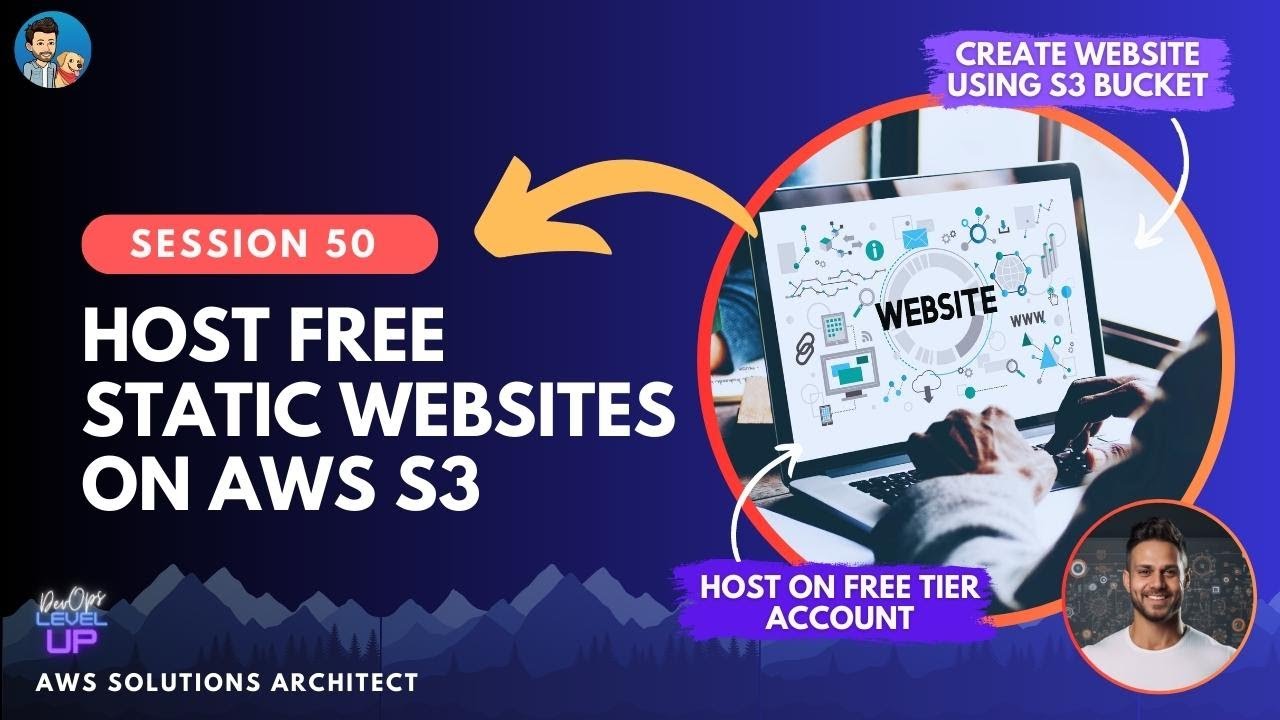Free static site hosting sets the stage for an exciting journey into the world of web development, offering a cost-effective and efficient way to launch your online presence. This approach leverages the power of static websites, which are essentially collections of HTML, CSS, and JavaScript files that are served directly to users’ browsers without requiring server-side processing.
Static websites are known for their lightning-fast loading speeds, enhanced security, and ease of maintenance, making them ideal for projects like personal portfolios, blogs, and simple landing pages. The availability of free static site hosting platforms further democratizes web development, allowing anyone with a creative vision to bring their ideas to life without breaking the bank.
What is Free Static Site Hosting?
Free static site hosting refers to the service of providing web space for static websites at no cost. These websites are typically built using HTML, CSS, and JavaScript, and they do not require a server-side language or database to function.
Static websites are different from dynamic websites in how they handle content. Static websites display pre-defined content that remains the same for all users, while dynamic websites generate content based on user input, database queries, or other factors.
Free Static Site Hosting Platforms
Several platforms offer free static site hosting. These platforms provide the necessary infrastructure to host your website, including storage space, bandwidth, and a domain name.
Here are some popular free static site hosting platforms:
- Netlify: Netlify is a popular platform known for its ease of use and powerful features. It offers automatic deployments, continuous integration and continuous delivery (CI/CD) tools, and a global content delivery network (CDN) for fast website loading times.
- GitHub Pages: If you use GitHub for version control, GitHub Pages provides a simple way to host your static website directly from your repository. It’s a great option for personal projects, portfolios, and documentation.
- Vercel: Vercel is another popular platform that focuses on speed and scalability. It offers a user-friendly interface, automatic deployments, and a global CDN.
- Surge: Surge is a simple and fast way to deploy static websites. It’s known for its command-line interface and quick deployment times.
- AWS S3: Amazon Web Services (AWS) offers free storage for static websites through Amazon S3. While it requires some technical knowledge to set up, it provides a cost-effective solution for larger websites.
Building a Static Website: Free Static Site Hosting

Building a static website is a straightforward process that involves creating content, structuring it using HTML, and applying CSS for styling. This approach offers a streamlined development process, making it ideal for projects requiring simple functionality and a focus on content delivery.
Methods for Creating Static Website Content
Static website content can be created using various methods, each with its own advantages and limitations.
- Plain Text Editing: This method involves directly writing HTML code using a text editor. It provides complete control over the website’s structure and content but requires familiarity with HTML syntax.
- WYSIWYG Editors: These editors offer a user-friendly interface that allows users to create web pages visually without writing code. While they simplify the process, they might limit customization options and could lead to bloated HTML code.
- Static Site Generators: These tools automate the process of generating HTML pages from templates and data. They streamline development, improve consistency, and facilitate content management. Popular examples include Jekyll, Hugo, and Eleventy.
Tools and Technologies Used in Static Website Development
Several tools and technologies are commonly used in static website development.
- HTML: The fundamental language for structuring web pages, defining elements like headings, paragraphs, and images.
- CSS: Used to style the appearance of web pages, controlling aspects like colors, fonts, and layout.
- JavaScript: While primarily used for dynamic websites, JavaScript can enhance static websites by adding interactive elements, animations, and improved user experiences.
- Version Control Systems: Tools like Git help manage changes to website code, enabling collaboration, tracking history, and reverting to previous versions.
- Image Optimization Tools: These tools help reduce image file sizes, improving website loading times and performance.
Limitations of Free Static Site Hosting

While free static site hosting offers a great starting point for web development, it’s crucial to understand its limitations. These limitations might not be immediately apparent, but they can significantly impact your website’s performance and scalability as it grows.
Limited Features
Free static site hosting providers often prioritize simplicity and ease of use. This means they might not offer advanced features that are common with paid hosting options.
- Custom Domains: Free hosting services typically restrict you to using a subdomain (e.g., yourwebsite.freehosting.com) instead of a custom domain (e.g., yourwebsite.com). This can affect your website’s branding and professionalism.
- SSL Certificates: SSL certificates are essential for securing your website and ensuring user trust. Free hosting services might not offer free SSL certificates, forcing you to purchase them separately.
- Email Accounts: Email accounts are often associated with a domain. Free hosting services may not provide email accounts, requiring you to use a separate email provider.
- Database Support: Dynamic websites require databases to store and manage data. Free static site hosting providers usually don’t offer database support, limiting your website’s functionality.
- Advanced Analytics: In-depth website analytics can help you understand your audience and optimize your content. Free hosting services might offer basic analytics, but they may lack the advanced features available with paid options.
Limited Storage and Bandwidth
Free hosting services typically have strict limits on storage space and bandwidth. These limitations can significantly affect your website’s performance and user experience.
- Storage Space: Free hosting services often provide limited storage space for your website files. This can restrict the size and number of images, videos, and other media you can use on your website.
- Bandwidth: Bandwidth refers to the amount of data that can be transferred between your website and users. Free hosting services might limit your bandwidth, leading to slow loading times and potential website downtime during peak traffic periods.
Suitability Considerations, Free static site hosting
Free static site hosting might not be suitable for all types of websites. It’s essential to consider the following factors before choosing a free hosting provider:
- Website Complexity: Free hosting services are best suited for simple websites with minimal functionality. If you plan to build a complex website with advanced features, a paid hosting option might be more appropriate.
- Traffic Expectations: Free hosting services might not be able to handle high traffic volumes. If you anticipate significant traffic, a paid hosting option with more robust infrastructure is recommended.
- Long-Term Goals: If you plan to grow your website and add new features, free hosting might not provide the flexibility and scalability you need. A paid hosting option with customizable features and resources might be a better investment in the long run.
Future Trends in Static Site Hosting

The world of static site hosting is constantly evolving, driven by advancements in technology and changing user expectations. New platforms, tools, and methodologies are emerging, shaping the future of how we build and deploy static websites. This section explores these trends and provides insights into the future of free static site hosting.
Increased Adoption of Jamstack
The Jamstack (JavaScript, APIs, and Markup) architecture is gaining significant traction. This approach leverages pre-rendered HTML, CSS, and JavaScript, combined with serverless functions and APIs for dynamic content and data fetching. Jamstack websites are known for their speed, security, and scalability, making them ideal for a wide range of applications.
Growth of Headless CMS
Headless Content Management Systems (CMS) are becoming increasingly popular for managing content for static websites. These systems separate the content backend from the frontend, allowing developers to use any frontend framework or technology while still benefiting from a powerful content management interface. Headless CMS platforms like Strapi, Contentful, and Prismic offer flexibility and scalability for static site development.
Advancements in Static Site Generators
Static site generators (SSGs) are continuously improving, offering more features and functionalities. New SSGs are emerging, along with updates to existing ones, introducing features like:
- Improved performance optimization tools
- Enhanced support for server-side rendering and dynamic content
- Integration with headless CMS platforms
- Advanced templating and data management capabilities
The Rise of Serverless Computing
Serverless computing platforms like AWS Lambda, Google Cloud Functions, and Azure Functions are revolutionizing how we deploy and manage backend logic. Serverless functions can handle tasks like data fetching, API requests, and dynamic content generation, making it easier to build interactive and dynamic static websites.
Enhanced Security Features
As static websites gain popularity, security becomes increasingly important. Free static site hosting providers are implementing advanced security features to protect websites from threats like DDoS attacks, SQL injection, and cross-site scripting (XSS).
Focus on Performance and Optimization
Performance is a crucial aspect of static site hosting. Free hosting providers are focusing on optimizing their infrastructure and services to deliver fast loading times and improve user experience. This includes using content delivery networks (CDNs) and optimizing website assets for faster loading.
Integration with AI and Machine Learning
Artificial intelligence (AI) and machine learning (ML) are finding their way into static site hosting. AI-powered tools can assist with tasks like content optimization, website performance analysis, and even website design.
Growth of Open Source Static Site Hosting Platforms
The open-source community is actively developing and maintaining free static site hosting platforms. These platforms offer flexibility, customization, and community support, making them attractive options for developers.
Expansion of Free Static Site Hosting Options
The number of free static site hosting providers is growing. New providers are entering the market, offering different features and functionalities to cater to various needs.
Increased Demand for Static Site Hosting
The demand for static site hosting is increasing due to its numerous benefits, including speed, security, and scalability. As more businesses and individuals adopt static websites, the free static site hosting market is expected to grow further.
Final Summary
Free static site hosting provides a compelling entry point for individuals and businesses seeking to establish a web presence without the complexities and expenses associated with traditional dynamic websites. With its inherent advantages of speed, security, and affordability, free static site hosting empowers anyone to create a professional online presence. While limitations may exist, the flexibility and ease of use offered by these platforms make them a valuable resource for a wide range of projects. As you embark on your journey into the world of static website hosting, explore the diverse options available and discover the potential of this powerful and accessible approach.




